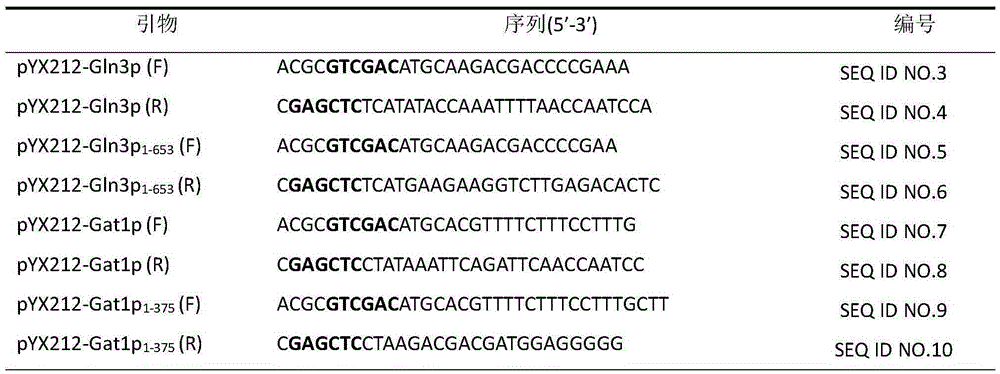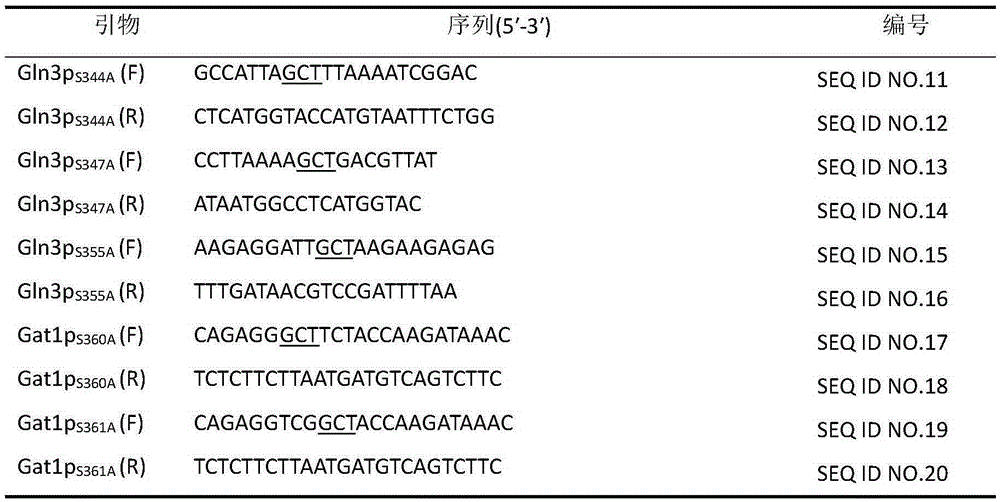Method with function of reducing accumulation of ethyl carbamate in rice wine fermentation
A technology of urethane and amino acid, applied in the field of microbial genetics and molecular biology, can solve problems such as accumulation of high-concentration urea
- Summary
- Abstract
- Description
- Claims
- Application Information
AI Technical Summary
Problems solved by technology
Method used
Image
Examples
Embodiment 1
[0034] Construction of Gln3p and Gat1p nuclear localization regulatory sequence deletion and truncated expression vector: primers were designed using the genome of Saccharomyces cerevisiae CEN. site; the reverse primer adds a SacI restriction endonuclease site) (see Table 1), PCR amplification to obtain truncated GLN3 and GAT1. The amplified gene fragment and the pYX212 plasmid were digested with SalI and SacI restriction enzymes respectively, and then ligated with DNA ligase to obtain pYX212-Gln3p 1-653 and pYX212-Gat1p 1-375 . The resulting plasmid was transformed into E.coliJM109 strain and sent to Shanghai Sangon Bioengineering Co., Ltd. for sequencing. It is verified that the plasmid with the correct gene sequence is used for the next step of the experimental operation. Construction of complete expression vectors of Gln3p and Gat1p (experimental control): primers were designed to amplify complete GLN3 and GAT1 (see Table 1). Construct pYX212-Gln3p and pYX212-Gat1p in ...
Embodiment 2
[0043] Example 2: Application
[0044] Referring to the rice wine production process of Zhejiang Guyue Longshan Company, the fermentation process of rice wine was simulated in the laboratory. The specific steps are as follows: take 100g of rice, soak it at room temperature for 2-3 days; after regular pressure cooking, add 17.4g of wheat koji (13.5g of raw wheat koji, 3.4g of cooked wheat koji), 170g of water, and the activated Saccharomyces cerevisiae The bacterial strain was inoculated into the culture medium according to the inoculation amount of 10% (v / v); the shake flask was added with a fermentation plug and left to ferment at 30°C; weighed every day, when the CO 2 Stop the pre-fermentation when the weight loss is less than 2g; place the shake flask at 15°C to continue the static fermentation, and finish the post-fermentation after 15 days, and take the fermentation liquid to test the content of urethane, urea, amino acids and flavor substances.
PUM
 Login to View More
Login to View More Abstract
Description
Claims
Application Information
 Login to View More
Login to View More - R&D Engineer
- R&D Manager
- IP Professional
- Industry Leading Data Capabilities
- Powerful AI technology
- Patent DNA Extraction
Browse by: Latest US Patents, China's latest patents, Technical Efficacy Thesaurus, Application Domain, Technology Topic, Popular Technical Reports.
© 2024 PatSnap. All rights reserved.Legal|Privacy policy|Modern Slavery Act Transparency Statement|Sitemap|About US| Contact US: help@patsnap.com










